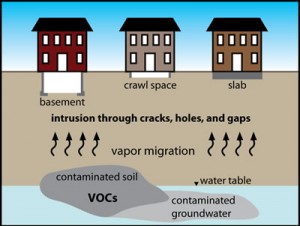Vapor Intrusion & Your Home
 Is Vapor Intrusion Causing Health Issues in Your Home?
Is Vapor Intrusion Causing Health Issues in Your Home?
Vapor intrusion problems can arise in almost any type of building. Particularly if the structure has been built in an area with contaminated groundwater or soil beneath it. Regardless of how long ago the contamination occurred, it could be impacting to the building structure above it. Many home and building owners are becoming more and more aware of the potential hazards that may be lurking in the air they breathe, particularly from pollutants such as asbestos, lead, mold, and radon. However, fewer are familiar with the issues and risks that may arise from the presence of vapor intrusion.
The EPA (Environmental Protection Agency) tells us that “vapor intrusion generally occurs when there is a migration of volatile chemicals from contaminated groundwater or soil into an overlying building. Volatile chemicals can emit vapors that may migrate through subsurface soils and into indoor air spaces of overlying buildings in ways similar to that of radon gas seeping into homes. Volatile chemicals may include volatile organic compounds, select semi-volatile organic compounds, and some inorganic analytes, such as elemental mercury, radon, and hydrogen sulfide”. VOC’s from contaminated soil or groundwater can enter buildings through cracks in the foundation and openings for utility lines and building ventilation and atmospheric conditions may help drive vapor intrusion.
The presence of these compounds within your breathing environment has the ability to pose long-term exposure rinks for building occupants and may results in a multitude of symptomatic responses. Typical signs or symptoms that have been associated with VOC exposure may include headache, allergic skin reactions, nose and throat discomfort, nausea, vomiting nose bleeding dizziness and fatigue.
It’s important to note that not all cases of vapor intrusion are detectable by odor alone. Often, specialized equipment may be needed to determine if the process is occurring within your home or commercial building, particularly if the levels that are present are not high enough to elicit a sensory irritation. Pay attention to any unusual or irritating odors within your home, and any health related symptoms that may be related to exposure to vapor intrusion. A professional indoor air quality testing & environmental consulting provider can help identify your risks and alert you of any potentially hazardous contaminates that may be hiding within your air. In many cases, knowing what is in your air is the first step to regaining a healthy indoor environment.


Follow Us!